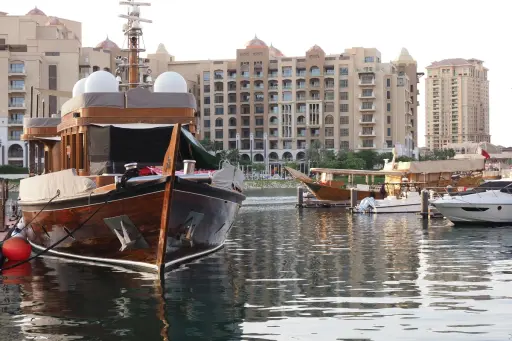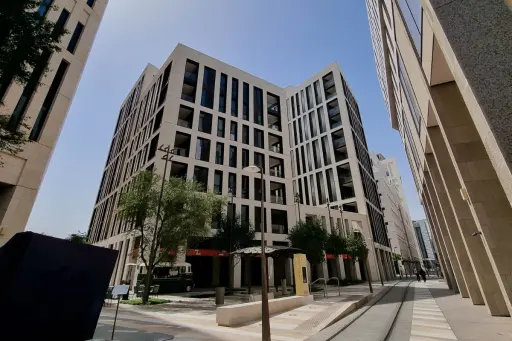Knight Frank
•09 Oct 2025
Waterfront vs. Inland Luxury: Which Qatari Locations Offer the Best ROI?
Investor Intelligence
Qatar's real estate market has matured considerably since the World Cup spotlight turned global attention toward Doha. Today, investors face an interesting choice: the glamorous waterfront lifestyle of The Pearl or the institutional backbone of Msheireb Downtown Doha. Both offer compelling cases, but the right answer depends entirely on your investment strategy and risk appetite.
After spending years tracking transaction data and speaking with landlords across both districts, I've learned that ROI isn't just about headline yields. It's about matching your property's strengths with market demand, managing your time effectively, and understanding which fundamentals actually drive returns in Qatar's unique market.
Understanding Qatar's Two Investment Personalities
The Pearl and Msheireb couldn't be more different in character. The Pearl draws its appeal from marina berths, beach clubs, and European-style piazzas. It's where expatriate families spend weekends and where short-stay visitors book premium apartments with Gulf views. Walk through Porto Arabia on a Thursday evening, and you'll see exactly who's paying the rent: international professionals, wealthy tourists, and second-home buyers from the GCC.
Msheireb Downtown Doha takes a completely different approach. This government-backed regeneration project sits in Doha's historic core, rebuilt as a smart-city showcase with LEED-certified buildings, tram connections, and a deliberate mix of residential, retail, and commercial space. The tenant base reflects that vision: ministries, professional services firms, Qatari families, and corporate executives who value a ten-minute commute over weekend beach access.
These differences aren't just aesthetic. They fundamentally shape your ROI potential, management burden, and exit strategy.
The Pearl: Chasing Higher ROI Through Short-Term Premium

Standard long-term rentals at The Pearl typically generate gross yields between 3-7%, which sounds modest until you factor in the short-term rental opportunity. Well-managed holiday lets in desirable towers can push gross returns to 7-10% during peak seasons particularly around major events, conferences, or the cooler winter months when European visitors escape to Gulf sunshine.
The mathematics work because you're capturing nightly rates that far exceed monthly rental equivalents. A two-bedroom apartment leasing for QAR 10,000 monthly might achieve QAR 500-700 per night as a serviced short-let. Run the numbers across a year with 65-70% occupancy, and your gross income jumps significantly.
But here's what the headline figures don't capture: management intensity. Short-term success at The Pearl demands professional property management, regular maintenance, competitive furnishing standards, and dynamic pricing strategies. You're essentially running a small hospitality business, which either costs 20-30% in management fees or requires significant personal involvement.
The tenant pool expatriates, tourists, and high-net-worth individuals also introduces volatility. Tourism cycles matter. Regional sentiment matters. When oil prices soften or global travel patterns shift, The Pearl feels it first. Vacancy periods can stretch longer than anticipated, particularly if you're competing against hotel inventory and dozens of similar apartments.
Capital appreciation at The Pearl follows a similar pattern: potentially strong during bullish periods, but sensitive to luxury market sentiment. Recent broker reports show continued price support in premium waterfront pockets, with single-digit percentage growth projected through 2025. The upside exists, but it's tied to sustained demand from foreign buyers and Qatar's success in building its tourism infrastructure.
For investors exploring luxury rental hotspots in Qatar, The Pearl certainly delivers on lifestyle appeal. The question is whether you have the operational capacity to extract its full ROI potential.
Msheireb Downtown: Building ROI on Institutional Foundations

Msheireb Downtown takes the opposite approach to returns. Gross yields typically range from 5-7% for quality mixed-use residential units, with some reports citing yields at the upper end of that range for well-located apartments. The numbers might look marginally lower than The Pearl's short-term peaks, but they come with something equally valuable: predictability.
The tenant mix tells the story. Government ministries occupy office floors. International professional services firms lease serviced apartments for relocating staff. Qatari families choose Msheireb for its central location and urban amenities. Corporate tenants sign longer leases, maintain properties carefully, and renew reliably. Vacancy risk drops considerably when your tenant isn't leaving after a week.
This stability flows through to ROI calculations in subtle but important ways. Lower vacancy means more consistent cash flow. Longer leases reduce tenant turnover costs. Corporate and government tenants generally require less hands-on management than short-stay visitors. Your net yield after management fees, service charges, and operating costs, stays closer to your gross yield because you're not absorbing the friction costs of constant turnover.
Capital appreciation follows a steadier trajectory as well. Msheireb benefits from its positioning as Qatar's flagship urban regeneration project, with government and institutional support underpinning demand. Recent transaction data from Knight Frank shows strong activity in Doha's central areas through 2025, reflecting confidence in core urban assets. Price movements tend to be less dramatic than waterfront trophy properties, but they're also less susceptible to luxury market corrections.
The liquidity story surprises many investors. Despite being less Instagram-worthy than The Pearl, Msheireb's mixed-use nature and institutional tenant base create consistent buyer interest. When you're ready to exit, there's typically a market, both from investors seeking stable income and from corporate buyers acquiring staff accommodation.
For those evaluating luxury property developments in Qatar, Msheireb represents the institutional-grade option: less glamorous, more dependable, and structured for investors who prioritize cashflow over speculation.
Matching Investment Strategy to ROI Profile
For active investors comfortable with short-term rental management, The Pearl offers superior ROI potential. If you can maintain high occupancy through dynamic pricing, professional property management, and quality furnishings, the premium nightly rates translate to genuinely attractive returns. This works best for investors who already operate rental portfolios, understand hospitality fundamentals, or partner with experienced management companies. Confirm local licensing requirements for holiday lets before committing, regulations around short-term rentals continue evolving.
For passive investors prioritizing stable income with minimal management, Msheireb becomes the logical choice. Long-term corporate leases, lower vacancy risk, and reduced management intensity mean your time investment drops while cash flow remains consistent. This suits investors building income-generating portfolios, retirees seeking reliable distributions, or busy professionals who can't dedicate time to active property management.
For capital preservation with moderate income, both locations work, but Msheireb edges ahead through lower volatility. Core urban assets with institutional tenancy weather market downturns more gracefully than luxury lifestyle properties. Your ROI might not spike during boom periods, but it's also less likely to crater during corrections.
For speculative capital appreciation, The Pearl offers higher upside in buoyant markets. Premium waterfront addresses can deliver outsized price movements when sentiment is strong and foreign capital flows freely into Gulf real estate. But this strategy requires accepting the inverse risk: luxury markets correct harder when conditions sour.
Stress-Testing Your ROI Assumptions
Whatever your choice, run conservative scenarios before committing capital. Start with gross yield, then strip out the real costs: service charges (often QAR 15-25 per square meter annually), property management (10-30% depending on service level), maintenance reserves, and any financing costs. Your net yield is what actually reaches your account.
Model vacancy conservatively. The Pearl's short-term model might achieve 70% occupancy in a good year, but what if it's 55%? Msheireb might stay at 95% with long-term corporate tenants, but what if your specific unit takes three months to lease?
Consider your exit timeline. The Pearl's liquidity depends on sustained luxury market sentiment. If you need to sell during a soft patch, you might wait longer or accept price concessions. Msheireb's diversified buyer pool institutions, owner-occupiers, income investors generally provides more consistent exit options for quality units.
Both locations benefit from Qatar's broader tailwinds: post-World Cup infrastructure, population growth, and government policies encouraging foreign investment and residency. Transaction volumes surged through 2025, with double-digit growth reported in quarterly data. The fundamentals support both districts, but they reward different investment approaches.
The Practical Qatar ROI Verdict
The Pearl delivers higher peak ROI potential for investors who can actively manage short-term rentals and accept seasonal volatility. If you have the operational capacity or budget for professional management and believe in Qatar's tourism growth story, the waterfront premium makes sense.
Msheireb offers superior risk-adjusted ROI for investors prioritizing stable cash flow, lower management burden, and institutional-quality tenancy. It's the choice for building predictable income streams without constant operational involvement.
Neither location is objectively superior. They're optimized for different investor profiles. The best ROI comes from honest self-assessment: what's your actual capacity for active management? How much volatility can you tolerate? What's your investment horizon?
Match your property choice to those answers, stress-test your assumptions with recent transaction data, and confirm freehold status and title transfer processes through proper legal channels. Get that framework right, and both The Pearl and Msheireb can deliver compelling returns in Qatar's evolving real estate landscape.